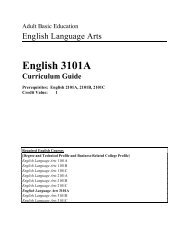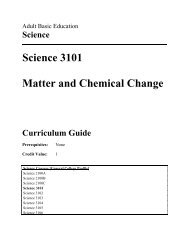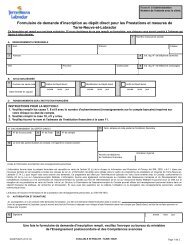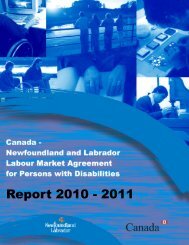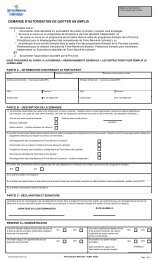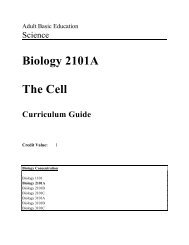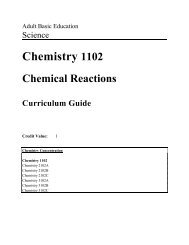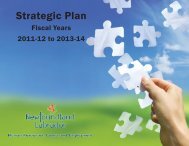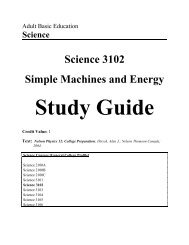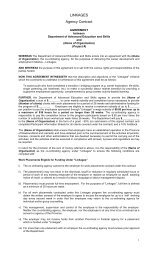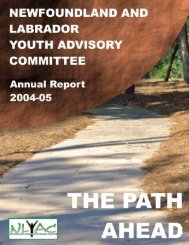Program Guide - Department of Human Resources, Labour and ...
Program Guide - Department of Human Resources, Labour and ...
Program Guide - Department of Human Resources, Labour and ...
You also want an ePaper? Increase the reach of your titles
YUMPU automatically turns print PDFs into web optimized ePapers that Google loves.
IS 3212<br />
Geology<br />
1. Rocks <strong>and</strong> Minerals<br />
1.1 Define mineral.<br />
1.2 Determine physical properties <strong>of</strong> minerals such as colour, streak, hardness, lustre,<br />
cleavage, specific gravity, fracture, <strong>and</strong> crystal form.<br />
1.3 Classify mineral samples as belonging to silicates, oxides, sulfides, carbonates,<br />
sulfates, or phosphates.<br />
1.4 List at least ten minerals <strong>and</strong> describe use <strong>of</strong> each mineral.<br />
1.5 Describe how sedimentary, metamorphic, <strong>and</strong> igneous rocks are formed.<br />
1.6 Explain how rocks are continuously being recycled.<br />
1.7 Describe rock samples considering rock fabric (size, shape, <strong>and</strong> distribution <strong>of</strong><br />
mineral grains), hardness, texture, rock structures (e.g., foliations, bedding), <strong>and</strong><br />
field occurrences.<br />
1.8 Explain the following methods <strong>of</strong> mineral exploration: geological, geophysical,<br />
geochemical, remote sensing, <strong>and</strong> diamond drilling.<br />
2. Weathering <strong>and</strong> Erosion<br />
2.1 Distinguish between weathering <strong>and</strong> erosion.<br />
2.2 Distinguish between physical <strong>and</strong> chemical weathering.<br />
2.3 Describe effects <strong>of</strong> weathering on buildings <strong>and</strong> l<strong>and</strong>scapes.<br />
2.4 Describe sources <strong>of</strong> acid rain pollution, including industrial, domestic, <strong>and</strong> natural<br />
sources.<br />
2.5 Explain formation <strong>of</strong> different soils through weathering action.<br />
2.6 Describe effects <strong>of</strong> human development <strong>and</strong> mismanagement on the surface <strong>of</strong><br />
the earth.<br />
3. Plate Tectonics<br />
3.1 Describe plate tectonics theory.<br />
3.2 Explain effects <strong>of</strong> divergent plate margins.<br />
3.3 Describe l<strong>and</strong>forms, rock types, <strong>and</strong> a divergent plate margins.<br />
3.4 Describe l<strong>and</strong>forms, rock types, <strong>and</strong> a convergent plate margins.<br />
3.5 Explain the following as they relate to plate tectonics: mountain belts, ocean<br />
trenches, ocean ridges, isl<strong>and</strong> arcs, hot spots, <strong>and</strong> subduction zones.<br />
3.6 Outline evidence supporting movement <strong>of</strong> plates.<br />
3.7 Describe cause <strong>of</strong> geologic plate movement.<br />
3.8 Explain how earthquakes <strong>and</strong> volcanoes are associated with development <strong>of</strong><br />
l<strong>and</strong>forms.<br />
235<br />
ABE Level III Curriculum




